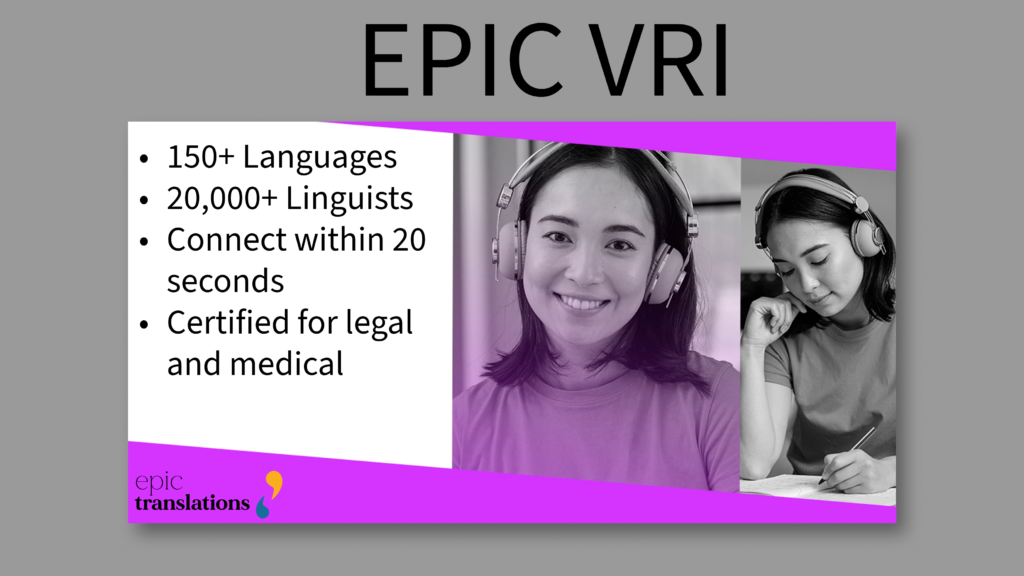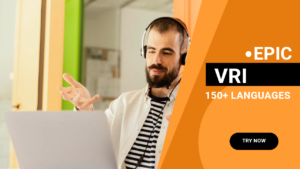The COVID-19 pandemic taught us valuable lessons about the potential for working, learning, and conducting a wide range of activities virtually. One key takeaway was the crucial role Certified Medical Interpreters played in ensuring effective communication in virtual healthcare settings. With their expertise, video remote interpreting (VRI) became an essential tool for bridging communication gaps, especially in critical environments like healthcare, education, and legal services. Some of the lessons we learned during the pandemic include:
- Remote work is viable and often productive
- Education can be delivered online, even if there are certain limitations
- Healthcare can be delivered remotely
- Virtual social connections can substitute, not necessarily replace real-life interactions
- Business models can adapt to a digital-first environment
- Remote workforce requires new management techniques
Video Remote Interpreting (VRI) has become a popular solution for bridging communication gaps, especially in healthcare, legal, and education settings.
However, some organizations might still wonder whether VRI is “good enough” compared to traditional, in-person interpreting.
This blog from EPIC Translations debunks common myths about VRI and explains why it’s a reliable option, particularly when used by certified medical interpreters and through on-demand services.
Myth 1: Myth 1: VRI Can’t Be as Effective as In-Person Interpreting with Certified Medical Interpreters
A common misconception about video remote interpreting (VRI), especially in healthcare, is that it can’t match the quality of in-person interpretation. While in-person has its advantages, VRI can be equally or more effective in certain situations.
For instance, on-demand VRI services provide immediate access to interpreters, even in rural or remote areas where it’s challenging to schedule an in-person interpreter. In critical healthcare settings, where time is of the essence, VRI ensures that patients receive timely, accurate communication. Many healthcare facilities prefer VRI because it offers flexibility, allowing them to summon an interpreter as soon as it’s needed without the logistics and delays of waiting for in-person assistance.
In fact, many certified medical interpreters are available through VRI platforms, ensuring that patients receive high-quality language services. These interpreters are trained professionals who adhere to strict confidentiality and ethical standards, making them suitable for sensitive environments like hospitals or legal proceedings.
Myth 2: VRI Doesn’t Provide the Same Personal Connection
Another common myth is that VRI lacks the personal touch that comes with in-person interpreting. Some argue that video technology creates a distance between the parties involved, leading to less effective communication.
However, advancements in VRI technology, including high-definition video and audio, have made it possible for interpreters to pick up on visual and verbal cues just as effectively as they would in person. In healthcare settings, for instance, being able to see a patient’s body language and facial expressions can be vital for understanding their needs and concerns. VRI platforms are designed to ensure a smooth interaction, and the real-time video allows interpreters to bridge cultural and linguistic gaps with ease.
Moreover, the availability of video remote interpreting in healthcare means that patients and providers can choose interpreters who are not only linguistically qualified but also culturally sensitive to specific needs. This can be especially useful in highly diverse environments where cultural nuances play a significant role in the delivery of care.

Myth 3: VRI Is Too Technical and Prone to Failure
Some organizations hesitate to adopt VRI because they worry about technical issues like poor internet connections, lagging audio, or malfunctioning video equipment. While no technology is entirely free from the occasional glitch, modern VRI systems are far more reliable than they were in the past.
On-demand VRI services typically use secure, cloud-based platforms that ensure reliable connections with minimal lag. Additionally, many VRI providers offer technical support to troubleshoot any issues quickly, ensuring that communication is not interrupted. These platforms are also HIPAA-compliant and secure, making them safe for handling sensitive medical and legal information.
Healthcare facilities are increasingly adopting VRI because of its dependability and convenience, especially when interpreters for rarer languages are required. As a result, patients receive the care they need without unnecessary delays or miscommunications.
Myth 4: VRI Isn’t Suitable for Specialized Fields Without Certified Medical Interpreters
Another misconception is that VRI is only suitable for simple, everyday conversations and isn’t appropriate for specialized fields like healthcare or legal settings. However, the reality is that certified medical interpreters and other specialized professionals are readily available through VRI platforms. These interpreters undergo rigorous training and certification processes to ensure they can handle complex terminology and sensitive conversations.
In fact, video remote interpreting has proven invaluable in medical settings, where clear and precise communication can literally save lives. From emergency room consultations to mental health evaluations, VRI allows healthcare providers to connect with interpreters who are experts in medical terminology and cultural nuances. EPIC VRI service has interpreters who are certified by National Council on Interpreting in Health Care (NCIHC).
Conclusion: Is VRI Good Enough?
The answer is a resounding yes. Video remote interpreting in healthcare and other industries has proven to be an effective, flexible, and reliable solution. By offering immediate access to certified medical interpreters through on-demand VRI services, organizations can ensure high-quality communication that meets the needs of diverse populations.
As technology continues to improve and become more integrated into our daily lives, the myths surrounding VRI will fade, and more organizations will realize its full potential. Whether it’s helping patients communicate with their doctors or enabling businesses to expand their global reach, VRI is more than good enough—it’s an essential tool for modern communication.
Want to Get Started with EPIC VRI?
Getting started with EPIC’s Video Remote Interpreting (VRI) solution is simple and efficient. Our platform offers access to certified interpreters, including specialists in medical and legal fields, on demand. Whether you’re in healthcare, education, or any other industry, EPIC VRI provides secure, real-time communication with the expertise you need. Simply go over to https://epictranslations.com/vri to get started right away!
Looking for an efficient and seamless way to bridge communication gaps? Our Video Remote Interpreting (VRI) service provides real-time language support, allowing you to connect with certified interpreters instantly, no matter where you are. Whether you’re hosting a business meeting, healthcare consultation, or legal session, VRI offers the flexibility of remote communication without sacrificing the accuracy and professionalism you expect. Contact us today using the below form to experience fast, reliable interpreting that enhances global connections and breaks language barriers!
[contact-form-7 id=”af8111d” title=”2024 Contact Form”]

